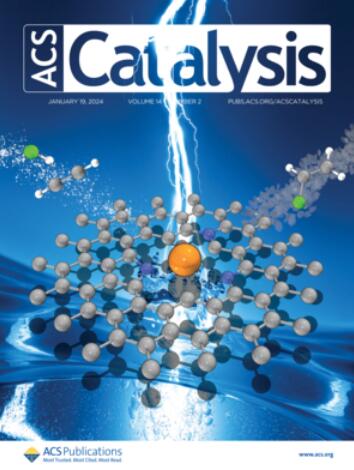电子转移诱导Pt-O-Cu双位点上氨氧化的机理研究
IF 11.3
1区 化学
Q1 CHEMISTRY, PHYSICAL
引用次数: 0
摘要
在商业Pt/Al2O3催化剂上,NH3氧化过程中N2选择性低主要是由于Pt位点促进NH3的过度氧化,导致形成不需要的副产物,如N2O和NO。在这项研究中,我们提出了一种新的策略,通过构建Pt-O-Cu双位点来提高N2选择性,同时保持NH3转化。这些双位点通过桥式晶格氧介导的表面电子转移表现出协同酸氧化还原特性。此外,表面吸附氧与晶格氧交换的能力显著提高。缺电子的Cu位点通过提供空的三维轨道来促进NH3的吸附,而富电子的Pt位点则促进NH3的脱氢。随后,在Pt位点上形成的- nhh或-N中间体可以与Cu位点上吸附的NH3反应生成N2,主要遵循综合选择性催化还原机制。优化后的双位点催化剂在180℃下NH3转化率和N2选择性达到95%以上。本文章由计算机程序翻译,如有差异,请以英文原文为准。

Mechanistic Insights into Ammonia Oxidation over Electron Transfer-Induced Pt–O–Cu Dual Sites
The low selectivity for N2 in the oxidation of NH3 over commercial Pt/Al2O3 catalysts is primarily due to the overoxidation of NH3 facilitated by Pt sites, leading to the formation of unwanted byproducts such as N2O and NO. In this study, we present a novel strategy to enhance N2 selectivity while maintaining NH3 conversion by constructing Pt–O–Cu dual sites. These dual sites exhibit synergistic acid-redox characteristics through surface electron transfer mediated by bridged lattice oxygen. Additionally, the ability of surface-adsorbed oxygen to exchange with lattice oxygen is significantly improved. The electron-deficient Cu sites enhance NH3 adsorption by providing empty 3d orbitals, while the electron-rich Pt sites promote NH3 dehydrogenation. Subsequently, the formation of –NH or –N intermediates at the Pt sites can react with adsorbed NH3 on the Cu sites to produce N2, predominantly following the integrated selective catalytic reduction mechanism. The optimized dual-site catalyst achieves over 95% NH3 conversion and N2 selectivity at 180 °C.
求助全文
通过发布文献求助,成功后即可免费获取论文全文。
去求助
来源期刊

ACS Catalysis
CHEMISTRY, PHYSICAL-
CiteScore
20.80
自引率
6.20%
发文量
1253
审稿时长
1.5 months
期刊介绍:
ACS Catalysis is an esteemed journal that publishes original research in the fields of heterogeneous catalysis, molecular catalysis, and biocatalysis. It offers broad coverage across diverse areas such as life sciences, organometallics and synthesis, photochemistry and electrochemistry, drug discovery and synthesis, materials science, environmental protection, polymer discovery and synthesis, and energy and fuels.
The scope of the journal is to showcase innovative work in various aspects of catalysis. This includes new reactions and novel synthetic approaches utilizing known catalysts, the discovery or modification of new catalysts, elucidation of catalytic mechanisms through cutting-edge investigations, practical enhancements of existing processes, as well as conceptual advances in the field. Contributions to ACS Catalysis can encompass both experimental and theoretical research focused on catalytic molecules, macromolecules, and materials that exhibit catalytic turnover.
 求助内容:
求助内容: 应助结果提醒方式:
应助结果提醒方式:


